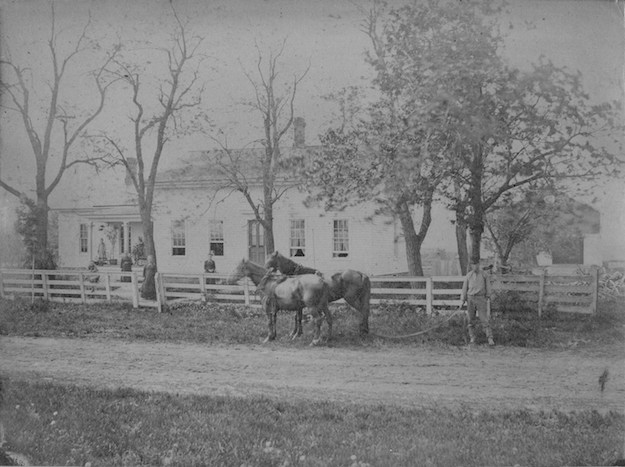Pioneers needed hard work, perseverance to clear land and build a life in Orleans

“Overlooked Orleans” – Volume 2, Issue 50
This photograph is part of my personal family collection, what I believe to be an image of the Joseph B. Pierce homestead on Route 31 in the town of Murray, immediately west of Hulberton Road.
Taken in the late 1870s we see a man, presumably Joseph Pierce, standing along the roadside with a team of horses. Standing in the front yard is Emma Brown Pierce and her four daughters Edith, Fanny, Florence, and Nettie – the latter clinging to the fence.
Joseph was the grandson of Aretas Pierce, Sr. who brought his family from Vermont to Murray in 1815. Upon their arrival to the virgin wilderness of Western New York, the family lived in a log schoolhouse for two weeks while they constructed a log cabin in April of that year. The family lived on provisions brought with them from New England for their first year on the land, but the poor harvest of the following year forced them to live on purchased food including salted pork. As rations ran out, the family boiled green wheat in milk to sustain themselves through the remainder of the season.
Aretas had settled his family on approximately 100 acres of land controlled by the Pulteney Estate, land that was not available for sale until 1821. Toiling for six years, the family cleared the land of dense forest and planted orchards with trees provided to them by Daniel Sturges of Clarendon. When the property was available for purchase, the price per acre was affixed at $8.00. Pierce was left with the choice of leaving his improved land or pay the exorbitant price, choosing the second option and remaining on the property. It was rumored that the Pulteney Association waited until the path of the Erie Canal was established in order to raise property value, a maneuver that was upsetting to many pioneers in the area.
According to David Sturges Copeland’s history of Clarendon, Daniel Pierce helped raise this home in 1828 on a northwestern portion of the original family lot, eight years before Joseph’s birth in 1836. The property was effectively transferred to Joseph in 1862, after he was rejected from service with the Union Army during the Civil War. Joseph was a Republican in political interests, casting his first vote for Abraham Lincoln and never failing to vote from that point forward.
Joseph’s two brothers, George W. and John Q. Pierce, both became civil engineers and engaged on expansion projects along the Erie Canal. John was placed in charge of various projects between Gasport and Shelby Basin before traveling westward to work on several railroad projects in the Illinois area. George followed a similar path, assisting in the widening of the locks at Lockport as well as expansion projects in the Holley vicinity.
Unlike his brothers, Joseph operated a modest farm on the family lot in Murray until his death in 1924. He did gain some notoriety in 1907 when a curious looking “animal freak” was born on the farm that spring. While birthing a calf, two bodies and eight legs appeared. Joseph assumed a set of calves were to be born until the remainder of the birthing process was completed. The “calf” consisted of two bodies and eight legs, but consisted of one head, joined at the shoulder, and three ears with the third protruding from the center of the head. The oddity lived only for a short period of time but attracted attention throughout the county.
The Pierce farm was handed down to Joseph’s youngest daughter, Nettie Pierce, who married Raymond Howard Handy in 1893. Bearing no children of their own, Raymond and Nettie fostered several children including Clarence Traub of Rochester – my great grandfather. This house, now a lavender color with purple shutters, still stands on Route 31 atop the hill just west of Hulberton Road.






































































